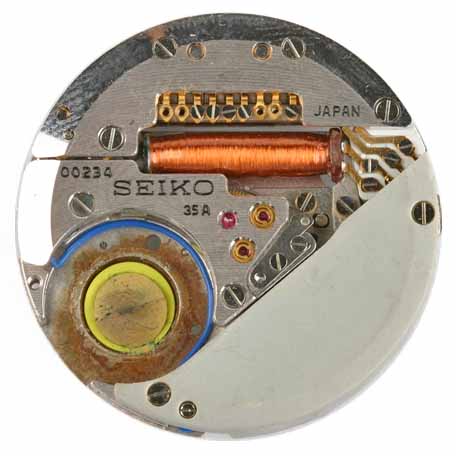WATCH FOUNDER
HISTRY OF WATCH
WATCH INVENT IN INDIA
BALANCING SPRING
FIRST WATCH
POKETWATCH
SOLAR WATCH
SMARTWATCH
MASSPRODUCTION
ELECTRICALWATCH
CONTACT US
|

In 1959 Seiko placed an order with Epson (a daughter company of Seiko and the 'brain' behind the quartz revolution)
to start developing a quartz wristwatch. The project was codenamed 59A. By the 1964 Tokyo Summer Olympics, Seiko had a working prototype of a portable quartz watch which was used as the time measurements throughout the event.
Quartz Movement of the Seiko Astron (1969)
The first quartz watch to enter production was the Seiko 35 SQ Astron, which hit the shelves on 25 December 1969, which was the world's most accurate wristwatch to date. Since the
technology having been developed by contributions from Japanese, American and Swiss, nobody could patent the whole movement of the quartz wristwatch, thus allowing other manufacturers to participate in the rapid growth and development of the quartz watch market,
This ended — in less than a decade — almost 100 years of dominance by the mechanical wristwatch legacy.
The introduction of the quartz watch in 1969 was a revolutionary improvement in watch technology.In place of a balance wheel which oscillated at 5 beats per second, it used a quartz crystal resonator which vibrated at 8,192 Hz, driven by a battery-powered oscillator circuit. In place of a wheel train to add up the beats into seconds, minutes, and hours, it used digital counters. The higher Q factor of the resonator, along with quartz's low temperature coefficient, resulted in better accuracy than the best mechanical watches, while the elimination of all moving parts made the watch more shock-resistant
and eliminated the need for periodic cleaning. The first digital electronic watch with an LED display was developed in 1970 by Pulsar. In 1974 the Omega Marine Chronometer was introduced, the first wrist watch to hold Marine Chronometer certification, and accurate to 12 seconds per year.
A Pulsar LED quartz watch (1976)
Accuracy increased with the frequency of the crystal used, but so did power consumption. So the first generation watches had low frequencies of a few kilohertz, limiting their accuracy. The power saving use of CMOS logic and LCDs in the second
generation increased battery life and allowed the crystal frequency to be increased to 32,768 Hz resulting in accuracy of 5–10 seconds per month. By the 1980s, quartz watches had taken over most of the watch market from the mechanical watch industry.
This upheaval, which saw the majority of watch manufacturing move to the Far East, is referred to in the industry as the "quartz crisis".
In 2010, Miyota (Citizen Watch) of Japan introduced a newly developed movement that uses a new type of quartz crystal with ultra-high frequency (262.144 kHz) which is claimed to be accurate to +/- 10 seconds a year, and has a smooth sweeping second hand rather than one that jumps.
 |

